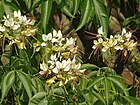Note: This is a project under development. The articles on this wiki are just being initiated and broadly incomplete. You can Help creating new pages.
Difference between revisions of "Crateva nurvala - Large Garlic Pear"
(→References) |
(→List of Ayurvedic medicine in which the herb is used) |
||
| Line 44: | Line 44: | ||
==List of Ayurvedic medicine in which the herb is used== | ==List of Ayurvedic medicine in which the herb is used== | ||
| + | [[Kaanchanaara Guggulu]], [[Dhanvantari Gritha]], [[Niri]], [[Purim]], [[Malatyadi Tailam]], [[Varunaadi Kashaayam]], [[Varunaadi Gritha]], [[Vaatasaani Taila]] | ||
==Where to get the saplings== | ==Where to get the saplings== | ||
Revision as of 16:31, 12 September 2023
Crateva Magna is a shrub or a tree. It will grow upto 2 - 20 metres tall. The tree is harvested from the wild for local use, Mainly as a medicine and source of wood. The plant is often cultivated as an Ornamental, Especially within its native range.
Contents
- 1 Uses
- 2 Parts Used
- 3 Chemical Composition
- 4 Common names
- 5 Properties
- 6 Habit
- 7 Identification
- 8 List of Ayurvedic medicine in which the herb is used
- 9 Where to get the saplings
- 10 Mode of Propagation
- 11 How to plant/cultivate
- 12 Commonly seen growing in areas
- 13 Photo Gallery
- 14 References
- 15 External Links
Uses
Kidney stone, Piles, Cervical odenitis, Swelling, Collyrium, Desentery, Wounds[1].
Parts Used
Stem's bark, Root's bark, Leaf[1].
Chemical Composition
Chemical Investigation of Crataeva nurvala leaves resulted in the isolation of four compounds, Which are Dodecanoic anhydride, Methyl pentacosanoate, Kaemferol-3-O-α-D-glucoside and Quercitin-3-O-α-D-glucoside.[2]
Common names
| Language | Common name |
|---|---|
| Kannada | Mavalinga mara, Holetakki, Holetumbe |
| Hindi | Baran, Barna |
| Malayalam | NA |
| Tamil | Kodikilangu |
| Telugu | Ulimiri, Chendupaddu |
| Marathi | NA |
| Gujarathi | NA |
| Punjabi | NA |
| Kashmiri | NA |
| Sanskrit | Kumaraja, Varuna, Setuvriksha |
| English | Holy garlic pear |
Properties
Reference: Dravya - Substance, Rasa - Taste, Guna - Qualities, Veerya - Potency, Vipaka - Post-digesion effect, Karma - Pharmacological activity, Prabhava - Therepeutics.
Dravya
Rasa
Guna
Veerya
Vipaka
Karma
Prabhava
Habit
Identification
Leaf
| Kind | Shape | Feature |
|---|---|---|
Flower
| Type | Size | Color and composition | Stamen | More information |
|---|---|---|---|---|
| Flowering from December to March |
Fruit
| Type | Size | Mass | Appearance | Seeds | More information |
|---|---|---|---|---|---|
| Fruiting from December to March |
Other features
List of Ayurvedic medicine in which the herb is used
Kaanchanaara Guggulu, Dhanvantari Gritha, Niri, Purim, Malatyadi Tailam, Varunaadi Kashaayam, Varunaadi Gritha, Vaatasaani Taila
Where to get the saplings
Mode of Propagation
How to plant/cultivate
Commonly seen growing in areas
Open forests, Often along streams, Sometimes near the seashore, Occurring mostly along streams in shady locations.
Photo Gallery
References
- ↑ 1.0 1.1 1.2 ”Karnataka Medicinal Plants Volume-3” by Dr.M. R. Gurudeva, Page No.610, Published by Divyachandra Prakashana, #6/7, Kaalika Soudha, Balepete cross, Bengaluru
- ↑ Indian Journals of Pharmaceutical Science - Chemical constituents of Crataeva nurvala (Buch-ham) leaves
- ↑ [Morphology]
- ↑ [Cultivation]
External Links
- Ayurvedic Herbs known to be helpful to treat Kidney stone
- Ayurvedic Herbs known to be helpful to treat Piles
- Ayurvedic Herbs known to be helpful to treat Cervical odenitis
- Ayurvedic Herbs known to be helpful to treat Swelling
- Ayurvedic Herbs known to be helpful to treat Collyrium
- Ayurvedic Herbs known to be helpful to treat Desentery
- Ayurvedic Herbs known to be helpful to treat Wounds
- Herbs with Stem's bark used in medicine
- Herbs with Root's bark used in medicine
- Herbs with Leaf used in medicine
- Herbs with common name in Kannada
- Herbs with common name in Hindi
- Herbs with common name in Tamil
- Herbs with common name in Telugu
- Herbs with common name in Sanskrit
- Herbs with common name in English
- Habit - Semi-deciduous Tree
- Index of Plants which can be propagated by Seed
- Herbs that are commonly seen in the region of Open forests
- Herbs that are commonly seen in the region of Often along streams
- Herbs that are commonly seen in the region of Sometimes near the seashore
- Herbs that are commonly seen in the region of Occurring mostly along streams in shady locations
- Herbs


